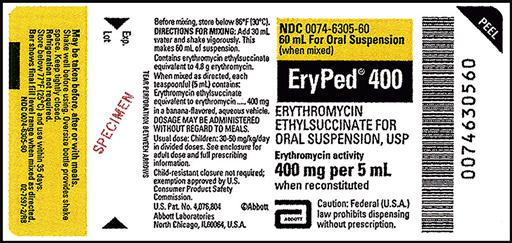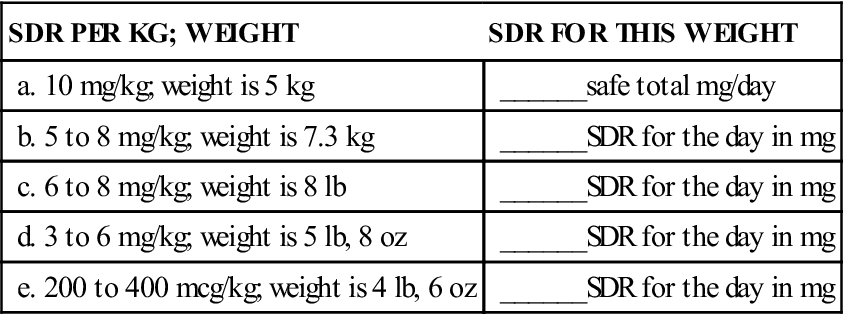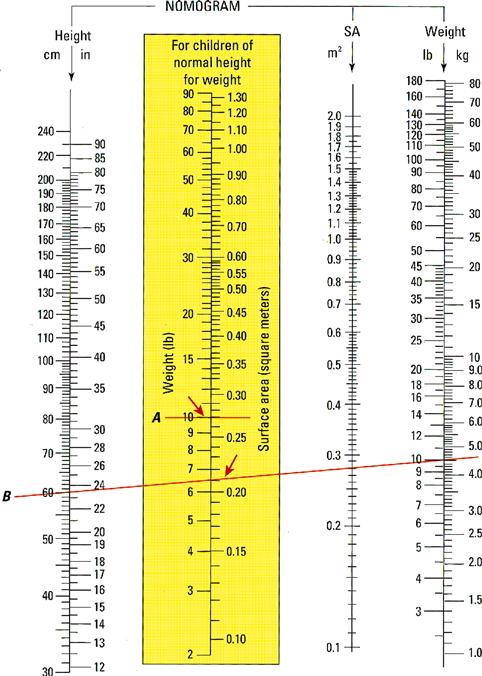Children’s Dosages
Introduction
The trend for increased medication administration safety is to customize all dose orders based on body weight or body surface area and condition, along with other safeguards. Powerful high-alert drugs and most drugs for at-risk populations such as infants and children, adults who are extremely frail, and people who are underweight or overweight often require several steps for safe administration. This chapter will focus on customized dosing of pediatric medication orders to provide practice with smaller fractional amounts of medication and ounce to pound to kg weight conversion, but the principles, skills, and steps for calculation apply to adults as well.
Dosages Based on Body Weight and Surface Area
Infants and children have special medication needs because of their smaller size and weight as well as larger body surface area (BSA) per kilogram of body weight. They have varying capabilities of drug absorption, digestion, distribution, metabolism, and excretion. It is very important for the nurse to check current references for pediatric medication orders and to double-check safe dose ranges (SDRs) to prevent errors and injury. Minute doses that require scrupulous mathematics may be ordered. Pediatric and intensive care nurses use written pediatric drug guidelines and calculators to determine weights and verify SDRs.
The two methods currently used for calculating safe pediatric doses are based on (1) body weight in mg/kg or mcg/kg and (2) body surface area in square meters (m2) using a scale called a nomogram.
mg/kg Method (Weight-Based Dosing)
The most frequently used calculation method for customized dosing is mg per kg. References usually state the safe amount of drug in mg per kg for a 24-hour period to be given in one or more divided doses. You may also see mcg per/kg cited for therapeutic doses when very small amounts of medication are to be given.
Steps to Solving mg/kg Problems
Step 1
Estimate the weight in kilograms by dividing the pounds in half*; then calculate the weight in kilograms using 2.2 lb = 1 kg equivalency (divide pounds by 2.2). Use a calculator.
a. If the weight is in pounds, convert the pounds directly into kilograms (one-step calculation).
b. If a weight is in pounds and ounces, convert the ounces to the nearest tenth of a pound and add this to the total pounds. Then convert the total pounds into kilograms to the nearest tenth (two-step calculation). (Refer to page 279 for kilogram-to-pound conversions and page 13 for rounding instructions.)
Step 2
Calculate the safe dose range (SDR) using a calculator and current safe dose recommendations found in the drug literature or drug handbook for this weight child in mg per kg or mcg per kg.
Step 3
Compare and evaluate the 24-hr ordered dose with the recommended SDR. Be sure the comparisons are for the same frequency!
Step 4
If safe, calculate the actual dose to be administered using written ratio and proportion. If the ordered dose is less than or more than the SDR, hold the medication and clarify promptly.
Shortcut Steps
RULE
All pediatric medication administration begins with an accurate weight (Step 1) and a calculation of the SDR (Step 2).
Example
Ordered: EryPed (erythromycin ethylsuccinate suspension) 150 mg po q6h for an infant with an infection. The infant weighs 15 lb, 6 oz today. The literature states that the SDR is 30 to 100 mg per/kg per day in four divided doses for severe infections.

Step 1
Estimate the infant’s weight.
Step 2
The SDR recommended for children more than 1 month of age is 30 to 100 mg/kg per day po in four divided doses.
| hoiv-range calculation: | 30 mg × 7 kg = 210 mg (low SDR) per day + 4 | = 52.5 mg/dose |
| High-range calculation: | 100 mg × 7 kg = 700 mg (high SDR) per day + 4 | = 175 mg/dose |
Step 3
Compare and evaluate: The SDR recommended for this child’s weight is 210 to 700 mg total q24h in four divided doses.
Ordered: 150 mg q6h or 150 mg × 4 or 600 mg total in 24 hr.
Step 4
Decision: Give medication. Administering 600 mg for the day is within the SDR of 210 to 700 mg in four divided doses.
Calculate the individual dose (write out and prove).

HINT
Review and analyze the logic of these four steps.
 CLINICAL ALERT
CLINICAL ALERT
Avoid two potential errors when converting pounds and ounces to kilograms. First, ounces must be converted to part of a pound before converting total pounds to kilograms; for example, 6 oz does not convert to 0.6 lb. Second, 15.4 lb does not equal 15.4 kg.
Don’t forget the second step—convert the total pounds to kilograms.
RULE
Calculators are used in pediatric and adult care units for long division and multiplication problems. Dividing ounces by 16 will give the pound equivalent in the first step of two-step problems. Dividing or multiplying by 2.2 will give pound and kilogram equivalents.
1. Estimate the weights, then use a calculator to convert from pounds to kilograms or kilograms to pounds. Round to the nearest tenth.* Double-check all work.
a. 14 lb (1 or 2 steps?) b. 12 lb, 2 oz (1 or 2 steps?)
Estimate: Estimate:
Actual: Actual:
c. 10 lb d. 14 kg
Estimate: Estimate:
Actual: Actual:
2. Calculate the 24-hr total dose in milligrams.
e. 750 mcg q12h
a. 1 g in 4 equally divided doses b. 750 mg divided tid
c. 2 g in 4 to 6 equally divided doses d. 16 g a day in 2 to 4 divided doses
4. Calculate the SDR in milligrams for the following weights. Note that the answers will only be in milligrams or micrograms because x, the unknown, is a dosage measurement not a weight measurement. You want to know how many milligrams a day and milligrams per dose are safe for this patient. (2.2 lb = 1 kg)
| SDR PER KG; WEIGHT | SDR FOR THIS WEIGHT |
| ______safe total mg/day | |
| ______SDR for the day in mg | |
| ______SDR for the day in mg | |
| ______SDR for the day in mg | |
| ______SDR for the day in mg |

5. Ordered: Drug X, 50 mg tid. SDR: 2 to 3 mg/kg given in three divided doses. Child’s weight is 18 kg.
b. SDR per dose
c. Total ordered dose for day and per dose
For each problem, use a calculator to determine the child’s weight in kilograms to the nearest tenth, calculate the SDR, and compare it with the order. If the total dose for 24 hours is excessive, the unit dose is automatically excessive. Evaluate the order and make a decision.
1. Weight: 20 lb
SDR in literature: 2 to 4 mg per kg per day
Ordered: 50 mg daily
2. Weight: 33 lb
SDR in literature: 100 to 200 mcg per kg per day in divided doses
Ordered: 0.5 mg tid
3. Weight: 25.4 lb
SDR in literature: 10 to 30 mg per kg per day in divided doses
Ordered: 100 mg tid
4. Weight: 85 lb
SDR: 10 to 15 mg/kg/day in 4 to 6 divided doses
Ordered: 100 mg q6h
5. Weight 5 lb
SDR: 10 to 20 mcg/kg/day
Ordered: 0.03 mg four times daily
BSA Method (mg/m2)
The term “body surface area” refers to the total area exposed to the outside environment. The estimated BSA in square meters (m2) is derived from height and weight measurements by using a mathematical formula. It is considered the most reliable way to calculate therapeutic dosages.
This method may be used to calculate safe dosages of antineoplastic drugs, of new drugs, and of drugs for special populations such as infants, children, frail elderly patients, and patients with cancer. It may also be used to double-check medication orders for safe dosage.
Example
Child weighs 33 lb (15 kg) and has a BSA of 0.55 m2.
| ORDERED: 20 mg/kg | vs ORDERED: 20 mg/m2 | vs ORDERED 20 mg/lb |
| 20 mg : 1 kg :: | 20 mg : 1 m2 :: | 20 mg : 1 lb :: |
| x mg : 15 kg | xmg : 0.55 | x mg : 33 lb |
| x = 20 × 15 = 300 mg | x = 20 × 0.55 = 11 mg | x = 20 × 33 = 660 mg |
As seen, the doses calculated range from 11 mg to 660 mg and, depending on the unit of measurement, reflect extremely large differences. This illustrates the need to check not only the numbers but also the units of measurement.
The West nomogram in Figure 12-1 allows the user to plot the estimated square meters of BSA by using height and weight measurements.
Although the pharmacy usually supplies BSA calculations, the nurse has the option of estimating safe dosages easily and rapidly by using a mathematical formula and a calculator and entering the patient’s height and weight data.
Calculating BSA (m2) Using a Mathematical Formula
There are two formulas for calculating BSA (m2), and both use height and weight dimensions.


Note the differences in the divisors. The formulas must be used exactly as shown.
Directions: Use a calculator. Use the metric formula. Determine the BSA in square meters for a child with a weight of 20 kg and a height of 95 cm.
Step 1
Multiply the kilograms by centimeters first and divide the result by 3600 (20 × 95 = 900/3600 = 0.527)
Step 2
Obtain the square root of 0.527 by pushing the square root button. Round your answer to the nearest hundredth.

Compare this answer with the West nomogram (see Figure 12-1). Create a straight line between 20 kg and 95 cm and read the result in the surface area (SA) column on the nomogram. Take care to plot the height and weight on the metric graph—;the outside columns. When reading the results (m2) columns, be sure to note the value of each calibrated line on the scale at the intersection point.
You may use either the nomogram or the formula. The formula method is more accurate, and if you have a calculator on hand, it is faster.
A square meter is slightly larger than a square yard. Visualize a square meter or a square yard of skin. As seen on the nomogram, a child of 90 lbs has only about 1 square meter of BSA (1 m2). Use one of the formulas to calculate your own BSA.
 CLINICAL ALERT
CLINICAL ALERT
Nurses are not usually expected to calculate BSA. The pharmacy provides the BSA calculations. Nurses do have a critical responsibility to distinguish the difference in a medication order and dosage based in mg/lb or mg/kg of weight and an order based on mg/m2 of BSA (e.g., 20 mg/kg vs 20 mg/m2 vs 20 mg/lb).
Use the West nomogram (page 282), highlighted section for children of normal height and weight, to obtain the BSA (m2) based on weight.
Calculate the dose to be given based on the mg/m2 and dose ordered.
| WT in lb | BSA in m2 | DOSE ORDERED | DOSE TO BE GIVEN | |
| 1. | 4 1b | 0.15 | 10 mg/m2 | 10 × 0.15 = 1.5 mg |
| 2. | 6 1b | _____ | 15 mg/m2 | _____ |
| 3. | 10 lb | _____ | 5 mg/m2 | _____ |

Calculate the dose for the same-weight children in mg/lb measurements, as illustrated in Problem 4.
| WT in lb | DOSE ORDERED | DOSE TO BE GIVEN | |
| 4. | 4 1b | 10 mg/lb | 4 × 10 = 40 mg |
| 5. | 6 1b | 15 mg/lb | _____ |
| 6. | 10 lb | 5 mg/lb | _____ |

Calculate the dose to be given in mg/kg measurements, as illustrated in Problem 9. Divide lb by 2.2 to obtain kg.
| WT in kg (to nearest tenth) | DOSE ORDERED | DOSE TO BE GIVEN | |
| 7. | 4 lb = 1.8 kg | 10 mg/kg | 10 × 1.8 = 18 mg |
| 8. | 6 lb =_____kg | 2 mg/kg |

9. Using a calculator, obtain the BSA in m2 (to the nearest hundredth for a child with a height of 60 cm and a weight of 100 kg using the appropriate BSA formula on page 281: ____________
10. Using a calculator, obtain the BSA in m2 for a child with a height of 30 in and weight of 35 lb using the appropriate BSA formula on page 281: ______________
 CLINICAL ALERT
CLINICAL ALERT
Consider the patient safety implications when mg/m2, mg/lb, and mg/kg are erroneously interchanged. This mistake has resulted in serious errors. The nurse must understand the differences among these three terms and focus to ensure that the correct values are being used when calculating the dose.
Estimate and calculate weights and doses. Evaluate the order. If dose is within the SDR, calculate and prove the answer.
1. Weight: 26 lb
SDR: 1 to 2 g/day in 4 divided doses
Ordered: 500 mg q6h
2. Weight: 44 lb, normal weight for height
SDR: 5 to 8 mg/m2* daily
Ordered: 4 mg daily
3. Weight: 19 lb
SDR: 0.1 to 0.3 mg/kg/day in 2 divided doses
Ordered: 2500 mcg bid
4. Weight: 9 lb
SDR 1 to 5 mcg/kg/day
Ordered: 0.01 mg daily
5. Weight: 14 lb
SDR: 0.02 to 0.05 mg/kg/day
Ordered: 150 mcg bid
Stay updated, free articles. Join our Telegram channel

Full access? Get Clinical Tree


 WORKSHEET 12A
WORKSHEET 12A WORKSHEET 12B
WORKSHEET 12B
 WORKSHEET 12C
WORKSHEET 12C WORKSHEET 12D
WORKSHEET 12D